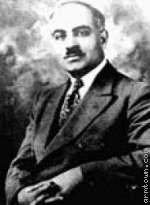
Armin Wegner
Armin Wegner, a German medic stationed in Turkey in 1915, smuggled his camera into an Armenia refugee camp.
"In the last few days, I have taken numerous photographs... on penalty of death. I do not doubt for a moment that I am committing a treasonable act. And yet I am inspired by the knowledge that I have helped these poor people in some small way. ...Hunger, death, disease, despair shout at me from all sides. Wretched me, for I carried neither bandages nor medications... I was seized by terror and hurried out of the camp, my heart pounding. I was overcome by dizziness, as if the earth were collapsing on both sides of me into an abyss...-- Armin Wegner, diary entry
The very same night that Allied troops landed at Gallipoli on 25 April 1915, the Turkish authorities began a process of repression of those whom they saw as internal enemies - the Armenian communities. Over the next two years the Armenian population of Ottoman Turkey was uprooted and expelled to the desert regions of Mesopotamia. In the process between 500,000 to one million Armenians where killed or died of exposure or disease. In the midst of the Great War, substantial parts of a long-established and prosperous civilian community with identifiable religious and cultural characteristics were wiped out.
Armin Wegner was a young German medic who visited an Armenian refugee camp, smuggling in his camera against orders. What he captured on film was a visual record of the first genocide of the 20th century. Years later, Wegner would send a letter to Adolph Hitler in defense of the Jewish people. It was a plea that fell on deaf ears, for Hitler would remark to his inner circle: "Who remembers the Armenia massacres today?"

No comments:
Post a Comment